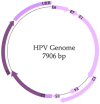The Involvement of Natural Polyphenols in the Chemoprevention of Cervical Cancer
- PMID: 34445518
- PMCID: PMC8396230
- DOI: 10.3390/ijms22168812
The Involvement of Natural Polyphenols in the Chemoprevention of Cervical Cancer
Abstract
From all types of cancer, cervical cancer manages to be in top four most frequent types, with a 6.5% rate of occurrence. The infectious vector that induces the disease, the high-risk Human papillomavirus (HPV), which is a sexually transmitted virus, is capable of transforming the host cell by modulating some of the principal signaling pathways responsible for cell cycle arrest, proliferation, and survival. Fortunately, like other cancer types, cervical cancer can be treated by chirurgical interventions or chemoradiotherapy, but these methods are not exactly the lucky clover of modern medicine because of the adverse effects they have. That is the reason why in the last years the emphasis has been on alternative medicine, more specifically on phytochemicals, as a substantial number of studies showed that diet contributes to cancer prevention and treatment. All these studies are trying to find new chemopreventive agents with less toxicity but high effectiveness both in vitro and in vivo. The aim of this review is to evaluate the literature in order to underline the advantages and disadvantages of polyphenols, a class of dietary compounds, as chemopreventive and chemotherapeutic agents. This review also aims to present polyphenols from different perspectives, starting with mechanisms of action and ending with their toxicity. The bigger picture illustrates that polyphenols have great potential in cervical cancer prevention, with strong effects on gene modulation.
Keywords: HPV; apoptosis; cervical cancer; phytochemicals; polyphenols; toxicity.
Conflict of interest statement
The authors declare no conflict of interest.
Figures







References
-
- UICC GLOBOCAN 2020: New Global Cancer Data. [(accessed on 25 April 2021)]; Available online: https://www.uicc.org/news/globocan-2020-new-global-cancer-data.
-
- Goodarzi E., Khazaei Z., Sohrabivafa M., Mansori K., Naemi H. Incidence and mortality of cervix cancer and their relationship with the human development index in 185 countries in the world: An ecology study in 2018. Adv. Hum. Biol. 2019;9:222. doi: 10.4103/AIHB.AIHB_15_19. - DOI
Publication types
MeSH terms
Substances
Grants and funding
LinkOut - more resources
Full Text Sources
Medical

